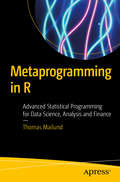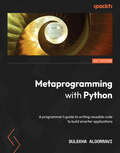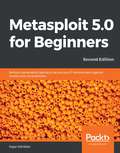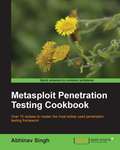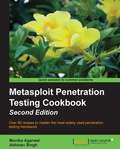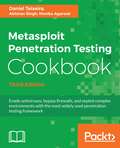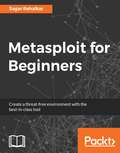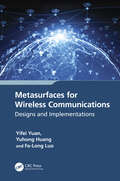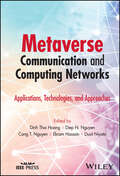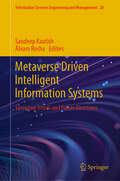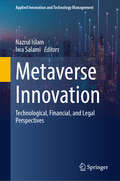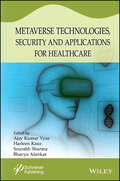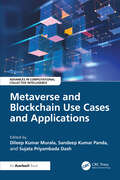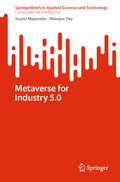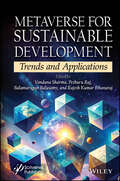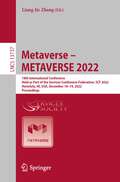- Table View
- List View
Metaprogramming in R
by Thomas MailundLearn how to manipulate functions and expressions to modify how the R language interprets itself. This book is an introduction to metaprogramming in the R language, so you will write programs to manipulate other programs. Metaprogramming in R shows you how to treat code as data that you can generate, analyze, or modify. R is a very high-level language where all operations are functions and all functions are data that can be manipulated. This book shows you how to leverage R's natural flexibility in how function calls and expressions are evaluated, to create small domain-specific languages to extend R within the R language itself. What You'll Learn Find out about the anatomy of a function in R Look inside a function call Work with R expressions and environments Manipulate expressions in R Use substitutions Who This Book Is For Those with at least some experience with R and certainly for those with experience in other programming languages.
Metaprogramming with Python: A programmer's guide to writing reusable code to build smarter applications
by Sulekha AloorRaviA practical approach to metaprogramming with real-world examples that enables the development of advanced frameworks, libraries, and applications using PythonKey FeaturesLearn applied metaprogramming through a simple step-by-step approachWork with easily understandable examples and explanations that take you deep into the theory of metaprogrammingGet practical experience in writing reusable code with real-world examplesBook DescriptionEffective and reusable code makes your application development process seamless and easily maintainable. With Python, you will have access to advanced metaprogramming features that you can use to build high-performing applications. The book starts by introducing you to the need and applications of metaprogramming, before navigating the fundamentals of object-oriented programming. Next, you will learn about simple decorators, work with metaclasses, and later focus on introspection and reflection. You'll also delve into generics and typing before defining templates for algorithms. As you progress, you will understand your code using abstract syntax trees and explore method resolution order. This Python book also shows you how to create your own dynamic objects before structuring the objects through design patterns. Finally, you will learn simple code-generation techniques along with discovering best practices and eventually building your own applications. By the end of this learning journey, you'll have acquired the skills and confidence you need to design and build reusable high-performing applications that can solve real-world problems.What you will learnUnderstand the programming paradigm of metaprogramming and its needRevisit the fundamentals of object-oriented programmingDefine decorators and work with metaclassesEmploy introspection and reflection on your codeApply generics, typing, and templates to enhance your codeGet to grips with the structure of your code through abstract syntax trees and the behavior through method resolution orderCreate dynamic objects and generate dynamic codeUnderstand various design patterns and best practicesWho this book is forIf you are an intermediate-level Python programmer looking to enhance your coding skills by developing reusable and advanced frameworks, then this book is for you. Basic knowledge of Python programming will help you get the most out of this learning journey.
Metareasoning for Robots: Adapting in Dynamic and Uncertain Environments (Synthesis Lectures on Computer Science)
by Jeffrey W. HerrmannThis book is a state of the art resource that robotics researchers and engineers can use to make their robots and autonomous vehicles smarter. Readers will be able to describe metareasoning, select an appropriate metareasoning approach, and synthesize metareasoning policies. Metareasoning for Robots adopts a systems engineering perspective in which metareasoning is an approach that can improve the overall robot or autonomous system, not just one component or subsystem. This book introduces key concepts, discusses design options for metareasoning approaches and policies, and presents approaches for testing and evaluation of metareasoning policies. After considering the conceptual design phase, it discusses how to implement metareasoning in the robot’s software architecture and how to synthesize metareasoning policies. Every chapter has references to valuable works on robotics and metareasoning, and the book uses examples from the author’s own research and from other research groups to illustrate these ideas. In addition, this book provides links to books and papers for readers who wish to investigate these topics further.
Metareference in Videogames (Routledge Advances in Game Studies)
by Theresa KrampeTaking an original, in-depth approach, this book investigates the forms and functions of metareference in videogames.Drawing on a rich body of research in game studies, transmedial narratology, and neighbouring disciplines, the author combines detailed close-reading-style analyses of the indie games What Remains of Edith Finch, The Magic Circle and OneShot with a breadth of examples and systematic analyses that span multiple genres as well as several decades of videogaming. In doing so, the book maps different metareferential elements that can be found in videogames and proposes an original model for their analysis, while showcasing the complex interrelations among different metareferential elements in contemporary videogames. This book will appeal to videogame researchers and transmedial narratologists as well as to those interested in metaization in media and popular culture across disciplines.
Metasploit
by David Kennedy Devon Kearns Jim O'Gorman Mati Aharoni<p>The Metasploit Framework makes discovering, exploiting, and sharing vulnerabilities quick and relatively painless. But while Metasploit is used by security professionals everywhere, the tool can be hard to grasp for first-time users. <p>Metasploit: The Penetration Tester's Guide fills this gap by teaching you how to harness the Framework and interact with the vibrant community of Metasploit contributors.Once you've built your foundation for penetration testing, you’ll learn the Framework's conventions, interfaces, and module system as you launch simulated attacks. You’ll move on to advanced penetration testing techniques, including network reconnaissance and enumeration, client-side attacks, wireless attacks, and targeted social-engineering attacks.Learn how to:–Find and exploit unmaintained, misconfigured, and unpatched systems–Perform reconnaissance and find valuable information about your target–Bypass anti-virus technologies and circumvent security controls–Integrate Nmap, NeXpose, and Nessus with Metasploit to automate discovery–Use the Meterpreter shell to launch further attacks from inside the network–Harness standalone Metasploit utilities, third-party tools, and plug-ins–Learn how to write your own Meterpreter post exploitation modules and scriptsYou'll even touch on exploit discovery for zero-day research, write a fuzzer, port existing exploits into the Framework, and learn how to cover your tracks. Whether your goal is to secure your own networks or to put someone else's to the test, Metasploit: The Penetration Tester's Guide will take you there and beyond.
Metasploit 5.0 for Beginners: Perform penetration testing to secure your IT environment against threats and vulnerabilities, 2nd Edition
by Sagar RahalkarA comprehensive guide to Metasploit for beginners that will help you get started with the latest Metasploit 5.0 Framework for exploiting real-world vulnerabilities Key Features Perform pentesting in highly secured environments with Metasploit 5.0 Become well-versed with the latest features and improvements in the Metasploit Framework 5.0 Analyze, find, exploit, and gain access to different systems by bypassing various defenses Book Description Securing an IT environment can be challenging, however, effective penetration testing and threat identification can make all the difference. This book will help you learn how to use the Metasploit Framework optimally for comprehensive penetration testing. Complete with hands-on tutorials and case studies, this updated second edition will teach you the basics of the Metasploit Framework along with its functionalities. You'll learn how to set up and configure Metasploit on various platforms to create a virtual test environment. Next, you'll get hands-on with the essential tools. As you progress, you'll learn how to find weaknesses in the target system and hunt for vulnerabilities using Metasploit and its supporting tools and components. Later, you'll get to grips with web app security scanning, bypassing anti-virus, and post-compromise methods for clearing traces on the target system. The concluding chapters will take you through real-world case studies and scenarios that will help you apply the knowledge you've gained to ethically hack into target systems. You'll also discover the latest security techniques that can be directly applied to scan, test, ethically hack, and secure networks and systems with Metasploit. By the end of this book, you'll have learned how to use the Metasploit 5.0 Framework to exploit real-world vulnerabilities. What you will learn Set up the environment for Metasploit Understand how to gather sensitive information and exploit vulnerabilities Get up to speed with client-side attacks and web application scanning using Metasploit Leverage the latest features of Metasploit 5.0 to evade anti-virus Delve into cyber attack management using Armitage Understand exploit development and explore real-world case studies Who this book is for If you are a penetration tester, ethical hacker, or security consultant who wants to quickly get started with using the Metasploit Framework to carry out elementary penetration testing in highly secured environments, then this Metasploit book is for you. You will also find this book useful if you're interested in computer security, particularly in the areas of vulnerability assessment and pentesting, and want to develop practical skills when using the Metasploit Framework.
Metasploit Bootcamp
by Nipun JaswalMaster the art of penetration testing with Metasploit Framework in 7 days About This Book • A fast-paced guide that will quickly enhance your penetration testing skills in just 7 days • Carry out penetration testing in complex and highly-secured environments. • Learn techniques to Integrate Metasploit with industry's leading tools Who This Book Is For If you are a penetration tester, ethical hacker, or security consultant who quickly wants to master the Metasploit framework and carry out advanced penetration testing in highly secured environments then, this book is for you. What You Will Learn • Get hands-on knowledge of Metasploit • Perform penetration testing on services like Databases, VOIP and much more • Understand how to Customize Metasploit modules and modify existing exploits • Write simple yet powerful Metasploit automation scripts • Explore steps involved in post-exploitation on Android and mobile platforms. In Detail The book starts with a hands-on Day 1 chapter, covering the basics of the Metasploit framework and preparing the readers for a self-completion exercise at the end of every chapter. The Day 2 chapter dives deep into the use of scanning and fingerprinting services with Metasploit while helping the readers to modify existing modules according to their needs. Following on from the previous chapter, Day 3 will focus on exploiting various types of service and client-side exploitation while Day 4 will focus on post-exploitation, and writing quick scripts that helps with gathering the required information from the exploited systems. The Day 5 chapter presents the reader with the techniques involved in scanning and exploiting various services, such as databases, mobile devices, and VOIP. The Day 6 chapter prepares the reader to speed up and integrate Metasploit with leading industry tools for penetration testing. Finally, Day 7 brings in sophisticated attack vectors and challenges based on the user's preparation over the past six days and ends with a Metasploit challenge to solve. Style and approach This book is all about fast and intensive learning. That means we don't waste time in helping readers get started. The new content is basically about filling in with highly-effective examples to build new things, show solving problems in newer and unseen ways, and solve real-world examples.
Metasploit Penetration Testing Cookbook
by Abhinav SinghThis is a Cookbook which follows a practical task-based style. There are plenty of code and commands used for illustration which make your learning curve easy and quick.This book targets both professional penetration testers as well as new users of Metasploit who wish to gain expertise over the framework. The book requires basic knowledge of scanning, exploitation, and Ruby language.
Metasploit Penetration Testing Cookbook, Second Edition
by Abhinav Singh Monika AgarwalThis book follows a Cookbook style with recipes explaining the steps for penetration testing with WLAN, VOIP, and even cloud computing. There is plenty of code and commands used to make your learning curve easy and quick.This book targets both professional penetration testers as well as new users of Metasploit, who wish to gain expertise over the framework and learn an additional skill of penetration testing, not limited to a particular OS. The book requires basic knowledge of scanning, exploitation, and the Ruby language.
Metasploit Penetration Testing Cookbook: Evade antiviruses, bypass firewalls, and exploit complex environments with the most widely used penetration testing framework, 3rd Edition
by Abhinav Singh Monika Agarwal Nipun Jaswal Daniel TeixeiraOver 100 recipes for penetration testing using Metasploit and virtual machines Key Features Special focus on the latest operating systems, exploits, and penetration testing techniques Learn new anti-virus evasion techniques and use Metasploit to evade countermeasures Automate post exploitation with AutoRunScript Exploit Android devices, record audio and video, send and read SMS, read call logs, and much more Build and analyze Metasploit modules in Ruby Integrate Metasploit with other penetration testing tools Book Description Metasploit is the world's leading penetration testing tool and helps security and IT professionals find, exploit, and validate vulnerabilities. Metasploit allows penetration testing automation, password auditing, web application scanning, social engineering, post exploitation, evidence collection, and reporting. Metasploit's integration with InsightVM (or Nexpose), Nessus, OpenVas, and other vulnerability scanners provides a validation solution that simplifies vulnerability prioritization and remediation reporting. Teams can collaborate in Metasploit and present their findings in consolidated reports. In this book, you will go through great recipes that will allow you to start using Metasploit effectively. With an ever increasing level of complexity, and covering everything from the fundamentals to more advanced features in Metasploit, this book is not just for beginners but also for professionals keen to master this awesome tool. You will begin by building your lab environment, setting up Metasploit, and learning how to perform intelligence gathering, threat modeling, vulnerability analysis, exploitation, and post exploitation—all inside Metasploit. You will learn how to create and customize payloads to evade anti-virus software and bypass an organization's defenses, exploit server vulnerabilities, attack client systems, compromise mobile phones, automate post exploitation, install backdoors, run keyloggers, highjack webcams, port public exploits to the framework, create your own modules, and much more. What you will learn Set up a complete penetration testing environment using Metasploit and virtual machines Master the world's leading penetration testing tool and use it in professional penetration testing Make the most of Metasploit with PostgreSQL, importing scan results, using workspaces, hosts, loot, notes, services, vulnerabilities, and exploit results Use Metasploit with the Penetration Testing Execution Standard methodology Use MSFvenom efficiently to generate payloads and backdoor files, and create shellcode Leverage Metasploit's advanced options, upgrade sessions, use proxies, use Meterpreter sleep control, and change timeouts to be stealthy Who this book is for If you are a Security professional or pentester and want to get into vulnerability exploitation and make the most of the Metasploit framework, then this book is for you. Some prior understanding of penetration testing and Metasploit is required.
Metasploit for Beginners: Perform Penetration Testing To Secure Your It Environment Against Threats And Vulnerabilities, 2nd Edition
by Sagar RahalkarAn easy to digest practical guide to Metasploit covering all aspects of the framework from installation, configuration, and vulnerability hunting to advanced client side attacks and anti-forensics. About This Book • Carry out penetration testing in highly-secured environments with Metasploit • Learn to bypass different defenses to gain access into different systems. • A step-by-step guide that will quickly enhance your penetration testing skills. Who This Book Is For If you are a penetration tester, ethical hacker, or security consultant who wants to quickly learn the Metasploit framework to carry out elementary penetration testing in highly secured environments then, this book is for you. What You Will Learn • Get to know the absolute basics of the Metasploit framework so you have a strong foundation for advanced attacks • Integrate and use various supporting tools to make Metasploit even more powerful and precise • Set up the Metasploit environment along with your own virtual testing lab • Use Metasploit for information gathering and enumeration before planning the blueprint for the attack on the target system • Get your hands dirty by firing up Metasploit in your own virtual lab and hunt down real vulnerabilities • Discover the clever features of the Metasploit framework for launching sophisticated and deceptive client-side attacks that bypass the perimeter security • Leverage Metasploit capabilities to perform Web application security scanning In Detail This book will begin by introducing you to Metasploit and its functionality. Next, you will learn how to set up and configure Metasploit on various platforms to create a virtual test environment. You will also get your hands on various tools and components used by Metasploit. Further on in the book, you will learn how to find weaknesses in the target system and hunt for vulnerabilities using Metasploit and its supporting tools. Next, you'll get hands-on experience carrying out client-side attacks. Moving on, you'll learn about web application security scanning and bypassing anti-virus and clearing traces on the target system post compromise. This book will also keep you updated with the latest security techniques and methods that can be directly applied to scan, test, hack, and secure networks and systems with Metasploit. By the end of this book, you'll get the hang of bypassing different defenses, after which you'll learn how hackers use the network to gain access into different systems. Style and approach This tutorial is packed with step-by-step instructions that are useful for those getting started with Metasploit. This is an easy-to-read guide to learning Metasploit from scratch that explains simply and clearly all you need to know to use this essential IT power tool.
Metasploit, 2nd Edition
by Daniel G. Graham David Kennedy Mati Aharoni Devon Kearns Jim O'GormanThe new and improved guide to penetration testing using the legendary Metasploit Framework.Metasploit: The Penetration Tester&’s Guide has been the definitive security assessment resource for over a decade. The Metasploit Framework makes discovering, exploiting, and sharing vulnerabilities quick and relatively painless, but using it can be challenging for newcomers.Written by renowned ethical hackers and industry experts, this fully updated second edition includes:Advanced Active Directory and cloud penetration testingModern evasion techniques and payload encodingMalicious document generation for client-side exploitationCoverage of recently added modules and commands Starting with Framework essentials—exploits, payloads, Meterpreter, and auxiliary modules—you&’ll progress to advanced methodologies aligned with the Penetration Test Execution Standard (PTES). Through real-world examples and simulated penetration tests, you&’ll:Conduct network reconnaissance and analyze vulnerabilitiesExecute wireless network and social engineering attacksPerform post-exploitation techniques, including privilege escalationDevelop custom modules in Ruby and port existing exploitsUse MSFvenom to evade detectionIntegrate with Nmap, Nessus, and the Social-Engineer ToolkitWhether you&’re a cybersecurity professional, ethical hacker, or IT administrator, this second edition of Metasploit: The Penetration Tester&’s Guide is your key to staying ahead in the ever-evolving threat landscape.
Metasurfaces for Wireless Communications: Designs and Implementations
by Fa-Long Luo Yifei Yuan Yuhong HuangThis book provides a comprehensive coverage of reconfigurable intelligent surface (RIS) based wireless communications by covering all the technology stages from working principles, theories and algorithms, system architectures, real-world implementations, and programming platforms through performance measurements and system testing. Metasurfaces for Wireless Communications: Designs and Implementations serves as a must-be read for everything related to the use of RIS in wireless networks. Authored by three experts in the field, the book is organized into five in-depth and well-designed chapters. The first chapter discusses the fundamentals of metasurfaces for wireless communications as well as the related evolution and requirements of RIS in 6G. The second chapter is devoted to the modeling and analyses of RIS for wireless communications by including electromagnetic field modeling and theoretical analyses of both large- and small-scale channel models. In Chapter 3, the authors mainly address properties’ characterizations and system design of metasurface devices. Chapter 4 examines relay and system implementations of RIS for wireless communications through basic system models, key design aspects, and system simulations and architectures. Chapter 5 discusses the standardization of RIS-aided wireless communications by providing an overview of the relay technologies, field trials, and roadmaps in 3GPP standardizations.This book serves not only as a comprehensive reference for professional engineers, researchers, manufacturers, network operators, software developers, service providers, and regulatory bodies aiming at the development, standardization, deployment, and applications of B5G and 6G mobile communications, but also as a textbook for graduate students in circuits, signal processing, wireless communications, information theory, microwave technology, and antenna and propagation.
Metasynthetic Computing and Engineering of Complex Systems
by Longbing CaoProvides a comprehensive overview and introduction to the concepts, methodologies, analysis, design and applications of metasynthetic computing and engineering. The author: * Presents an overview of complex systems, especially open complex giant systems such as the Internet, complex behavioural and social problems, and actionable knowledge discovery and delivery in the big data era. * Discusses ubiquitous intelligence in complex systems, including human intelligence, domain intelligence, social intelligence, network intelligence, data intelligence and machine intelligence, and their synergy through metasynthetic engineering. * Explains the concept and methodology of human-centred, human-machine-cooperated qualitative-to-quantitative metasynthesis for understanding and managing open complex giant systems, and its computing approach: metasynthetic computing. * Introduces techniques and tools for analysing and designing problem-solving systems for open complex problems and systems. Metasynthetic Computing and Engineering uses the systematology methodology in addressing system complexities in open complex giant systems, for which it may not only be effective to apply reductionism or holism. The book aims to encourage and inspire discussions, design, implementation and reflection of effective methodologies and tools for computing and engineering open complex systems and problems. Researchers, research students and practitioners in complex systems, artificial intelligence, data science, computer science, and even system science, cognitive science, behaviour science, and social science, will find this book invaluable.
Metaverse Communication and Computing Networks: Applications, Technologies, and Approaches
by Dusit Niyato Ekram Hossain Dinh Thai Hoang Diep N. Nguyen Cong T. NguyenMetaverse Communication and Computing Networks Understand the future of the Internet with this wide-ranging analysis “Metaverse” is the term for applications that allow users to assume digital avatars to interact with other humans and software functions in a three-dimensional virtual space. These applications and the spaces they create constitute an exciting and challenging new frontier in digital communication. Surmounting the technological and conceptual barriers to creating the Metaverse will require researchers and engineers familiar with its underlying theories and a wide range of technologies and techniques. Metaverse Communication and Computing Networks provides a comprehensive treatment of Metaverse theory and the technologies that can be brought to bear on this new pursuit. It begins by describing the Metaverse’s underlying architecture and infrastructure, physical and digital, before addressing how existing technologies are being adapted to its use. It concludes with an overview of the challenges facing the Metaverse. The result is a thorough introduction to a subject that may define the future of the internet. Metaverse Communication and Computing Networks readers will also find: Detailed treatment of technologies, including artificial intelligence, Virtual Reality, Extended Reality, and more Analysis of issues including data security, ethics, privacy, and social impact A real-world prototype for Metaverse applications Metaverse Communication and Computing Networks is a must-own for researchers and engineers looking to understand this growing area of technology, and entrepreneurs interested in establishing Metaverse businesses.
Metaverse Driven Intelligent Information Systems: Emerging Trends and Future Directions (Information Systems Engineering and Management #20)
by Álvaro Rocha Sandeep KautishThe Metaverse has revolutionized the landscape of designing and implementing modern information systems by introducing a new dimension of connectivity and interaction. Information systems, traditionally confined to desktop applications and web platforms, have now expanded into immersive virtual spaces, blurring the lines between the physical and digital worlds. This shift has led to the integration of real-time data sharing, collaboration, and communication within the Metaverse, enhancing user experiences and data accessibility. Metaverse driven Intelligent Information Systems embodies knowledge based behavior which enables them to act intelligently and interact with end users & other systems in the process of solving variety of problems i.e. classification, retrieval, discovery and manipulation of hidden patterns and useful insights of data which leads to decision making process. IIS also deals with fetching, classifying, retrieving, and storing multimedia data for creating intelligent visual user interfaces for enhanced user experiences. This book presents fresh ideas and latest advances in the field of Intelligent Information Systems powered by Metaverse and related applications in the different areas i.e. optimization of complex systems, medical diagnosis, robotics and automation, and time series predictions. The proposed book is intended for readers i.e. researchers and professors in the field of computer science working on various new directions and aspects of intelligent information systems and machine intelligence. Distinguished Features of the proposed book – State-of-art documentation of Metaverse driven Intelligent Information Systems and their applications right from beginner level to advanced level. Excellent reference material for academic scientists, researcher and research scholars working in modern information systems domain. This book will showcase the recent innovations, trends, and concerns as well as applied challenges encountered and solutions adopted in the fields of Metaverse and Information Systems design and development.
Metaverse For Dummies
by Ian KhanYour first step to understanding what the metaverse is all about You've probably heard that the metaverse—a word that seemingly went from nonexistent to everywhere — is the next big thing in technology. What is it, anyway? Written by a leading futurist, Metaverse For Dummies unravels the mysteries of the metaverse, for the curious and for anyone looking to get in on the ground floor. Discover how to carve out your niche in the metaverse with easy-to-understand breakdowns of the major technologies and platforms, a guide to doing business in the metaverse, and explorations of what meta means for sports, education, and just about every other area of life. The book even gives you a guide to safety in the metaverse, including how much of your real life you should share in your virtual one. This book answers all the big questions about the metaverse, in simple terms. Explore the metaverse and the major players Get a look at how the metaverse will disrupt industries from gaming to online commerce Discover business opportunities on the metaverse Dive into metaverse gaming and virtual events—safely This book is a must for anyone looking for an approachable primer on what the metaverse is, how it works, and the opportunities within it.
Metaverse Innovation: Technological, Financial, and Legal Perspectives (Applied Innovation and Technology Management)
by Nazrul Islam Iwa SalamiThe Metaverse can be defined as an immersive 3-D simulated digital environment that deploys technologies like augmented reality, virtual reality, blockchain, and artificial intelligence to imitate the real world and allow people to conduct daily activities through digital versions of themselves (avatars). The opportunities brought by the metaverse for the economy and the society are wide in scope from business models to equitable education possibilities. This prompts regulators and policymakers around the world to assess the crucial legal and regulatory issues that arise in the process of metaverse development. This book offers a comprehensive understanding of metaverse innovation from technological, financial, and legal perspectives. It offers the basics of the metaverse, such as its enabling technologies, main characteristics and the global trends that shape its development. It also reviews the positive and negative impact of the metaverse on different sectors of the economy as well as the implications for policy and law.
Metaverse Technologies, Security, and Applications for Healthcare
by Sourabh Sharma Harleen Kaur Ajay Kumar Vyas Bhavya AlankarUnlock the transformative potential of the Metaverse with this crucial book that delves into vital information, security concerns, and innovative applications that can significantly enhance personalized patient care in a rapidly evolving digital landscape. This book explores insights into information security concerns, preventive measures, and their impact on healthcare applications in the Metaverse. The Metaverse is an amplified virtual world derived from the conjunction of virtual and physical space, where users can interact in an augmented world to meet each other virtually and engage in virtual activities that give authentic practice. The healthcare industry will tremendously benefit from this technology by using it to enhance personalized care for clients. Public health experts believe that while much has been said about the potential of the Metaverse in the entertainment and gaming industry, healthcare is another industry where its impact could be transformational. This volume provides a better understanding of healthcare applications in the Metaverse and why digital information security is of major concern. Recently, the world saw the impacts of the COVID-19 pandemic, which physically stopped mobility. Life is taken care of using digital interactions and the movement of information digitally through the Metaverse. This book explores implementation issues and performance evaluations of emerging technologies, along with research results and networking methods to demonstrate the immense benefits of this emerging technology. Readers will find this book: Provides comprehensive coverage of the Metaverse, including theoretical modeling of Metaverse architecture and protocols, prospective challenges, and information security; Explores wide applications of the Metaverse and their relevance in healthcare; Introduces solutions to real-life problems and the future prospects of the Metaverse. Audience Researchers, students, educators, and healthcare professionals focused on information communication technologies and their benefits in healthcare.
Metaverse and Blockchain Use Cases and Applications (Advances in Computational Collective Intelligence)
by Sandeep Kumar Panda Sujata Priyambada Dash Dileep Kumar MuralaEmbark on a journey into the intersection of the metaverse and blockchain with Metaverse and Blockchain Use Cases and Applications. This book goes beyond theoretical concepts and offers a pragmatic exploration of how these innovative technologies are revolutionizing industries and creating tangible impact in everyday life. Through a series of illustrative case studies, the book unveils how blockchain technology is reshaping the architecture of virtual worlds and is providing a secure and transparent foundation for digital experiences.The book helps readers understand how non-fungible tokens (NFTs) are transforming entertainment, gaming, and art industries through real-world applications, while exploring blockchain's crucial role in establishing digital scarcity, provenance, and authenticity—fundamental elements that enable a new era of trust and ownership in the metaverse. From supply chain management to decentralized identity solutions, the book sheds light on how these technologies are solving real- world challenges. The book also uncovers the impact of decentralized finance (DeFi) in the metaverse, where blockchain-driven financial ecosystems provide inclusive and accessible financial services to users across the globe. Highlights include: The role of privacy, data integrity, and accountability in blockchain systems The impact of blockchain on Industry 4.0 Blockchain in future wireless mobile networks Blockchain technology's application in the healthcare industry Blockchain technology in higher education This book helps individuals and organizations use the metaverse and blockchain in the real world by guiding them through implementations. It explores practical applications that merge the virtual and the tangible in a new interconnected digital environment.
Metaverse and Immersive Technologies: An Introduction to Industrial, Business and Social Applications (Artificial Intelligence and Soft Computing for Industrial Transformation)
by Sheng-Lung Peng Sandeep Kumar Panda S. Balamurugan Chandrashekhar A, Shaik Himam SahebMETAVERSE AND IMMERSIVE TECHNOLOGIES The book covers the multidimensional perspectives of the metaverse through the prism of virtual reality, augmented reality, blockchain, artificial intelligence, and IoT, ranging from rudimentary to advanced applications. This book provides a thorough explanation of how the technology behind metaverse and other virtual reality technologies are changing the world. The primary objective is to present the revolutionary innovation of the 21st century—the metaverse—and exhibit its wide range of applications in different domains. Although blockchain and VR/AR were the first popularly known applications of the metaverse, several other applications also exist. While some still believe the metaverse is overhyped, in reality, it is transforming almost every industry—healthcare, 3D, 4D, industry, game industry, business management, artificial intelligence, and IoT, just to name a few. This technological breakthrough not only paved the way for virtual reality but also provided useful solutions for other areas of technology. The unique nature of the technology, which is a single, shared, immersive, persistent, 3D virtual space where humans experience life in ways not possible in the physical world, makes it suitable for all real-world applications; it has great potential to transform business, and companies are already in the race for different product offerings. Audience AI and computer science researchers, engineers and graduate students, IT personnel in business as well as entrepreneurs and policymakers.
Metaverse for Industry 5.0 (SpringerBriefs in Applied Sciences and Technology)
by Nilanjan Dey Soumi MajumderThis book provides a detailed picture of the metaverse for industry 5.0. In the context of Industry 5.0, the concept of the metaverse aligns with the vision of Web 4.0, representing a digital ecosystem where individuals and organizations collaborate in a human-centric approach to create personalized value.This virtual universe connects multiple interconnected worlds, enabling real-time interactions between users and computer-generated environments. By integrating technologies such as artificial intelligence (AI), virtual reality (VR), augmented reality (AR), mixed reality(MR) and the Internet of Things (IoT), the metaverse within Industry 5.0 aims to foster innovation and enhance productivity, efficiency, and overall well-being through tailored and value-driven solutions. This book explores the concept of the metaverse in the context of Industry 5.0, highlighting its definition, evolution, advantages, and disadvantages. It also discusses pillars of technological advancement, challenges, and opportunities, ethical issues including its integration into various sectors, i.e., healthcare, construction, manufacturing and others. The entry concludes with a proposal for a conceptual framework for integrating the human-centric metaverse.
Metaverse for Sustainable Development: Trends and Applications
by Pethuru Raj Balamurugan Balusamy Rajesh Kumar Dhanaraj Vandana SharmaUnlock the future of technology and sustainable development by purchasing Metaverse for Sustainable Development: Trends and Applications, a comprehensive guide that delves into immersive application building, groundbreaking innovations, and the transformative potential of the metaverse across various industries. Metaverse for Sustainable Development: Trends and Applications explains the fine details of metaverse application building, demonstrating how integrated platforms in association with a suite of tools come in handy for enabling application construction. The metaverse is the next big thing influenced by virtual and augmented reality paradigms. This user experience will be more immersive and mesmerizing, empowering innovative, disruptive, and transformative technologies to create a spectacular platform for visualizing and realizing business-critical and people-centric metaverse systems. This book explores various metaverse models for healthcare information systems, including the latest technologies, such as the Brain-Computer Interface. Through real-world data and case studies, readers will gain a comprehensive understanding of the metaverse’s potential for the Internet of Things, blockchain, artificial intelligence, 5G, and 3D modelling for creating and sustaining immersive virtual worlds. Metaverse for Sustainable Development: Trends and Applications is a vital resource for understanding the end-to-end implementation of metaverse technologies.
Metaverse kompakt: Begriffe, Konzepte, Handlungsoptionen
by Ralf T. Kreutzer Sonja KloseDieses Buch ist ein erster Aufschlag, um die Auseinandersetzung mit dem Metaverse in Wissenschaft und Praxis voranzutreiben. Wie wird das Metaverse aussehen? Worum geht es? Wo stehen wir? Was benötigen wir? Wohin geht die Reise? Zunächst ist das Metaverse eine Idee bzw. ein Versprechen. Ralf T. Kreutzer und Sonja Klose versuchen, eine Vision greifbar und vorstellbar zu machen. Wie beim Internet ist es zu diesem Zeitpunkt schwierig vorherzusagen, welche Entwicklungen und Technologien von welchen Personen und Unternehmen in welcher Art und Weise erstellt und kombiniert werden.Die Autoren nehmen Sie an die Hand und empfehlen Ihnen: Ignorieren Sie diese Entwicklungen nicht! Es müssen nicht gleich umfassende Investitionen ins Metaverse getätigt werden. Aber ein paar Fingerübungen sind ratsam. Damit Sie schon an Bord sind, wenn der Zug tatsächlich Fahrt aufnimmt. Außerdem kann es Ihnen beim Employer Branding zu Vorteilen verhelfen, wenn sichtbar wird, dass Sie sich auch mit spannenden Zukunftsthemen beschäftigen.„Das vorliegende Werk zeigt einen spannenden, wissenschaftlich gut fundierten Blick auf das Metaverse.“ Dirk Lueth, Co-Founder von Upland und Mitverfasser des Werkes „Navigating the Metaverse“
Metaverse – METAVERSE 2022: 18th International Conference, Held as Part of the Services Conference Federation, SCF 2022, Honolulu, HI, USA, December 10–14, 2022, Proceedings (Lecture Notes in Computer Science #13737)
by Liang-Jie ZhangThis book constitutes the refereed proceedings of the 18th METAVERSE 2022 conference, held as part of the Services Conference Federation, SCF 2022, in December 2022 in Honolulu, USA. The 7 full papers and 3 short papers presented were carefully reviewed and selected from 21 submissions. The papers cover topics in the field of Advertising Services, Banking Services, Broadcasting & Cable TV Service, Business Services, Communications Services, Government Services, Real Estate Operations Services, Schools and Education Services, Healthcare Services, and much more.
